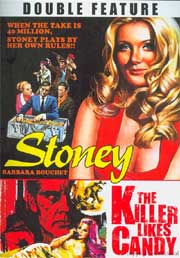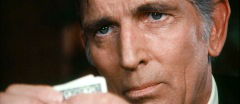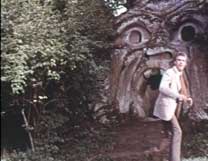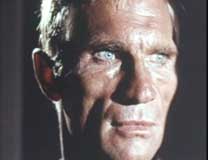 STONEY
(1969)/THE KILLER LIKES CANDY (1968)
STONEY
(1969)/THE KILLER LIKES CANDY (1968)Directors: Wray Davis/Richard Owens (Federico Chentrens) & Maurice Cloche
Code Red Releasing
 STONEY
(1969)/THE KILLER LIKES CANDY (1968)
STONEY
(1969)/THE KILLER LIKES CANDY (1968)Barbara Bouchet takes to the Philippines in search of stolen loot as STONEY while Kerwin Matthews tangles with a sweet-toothed assassin in THE KILLER LIKES CANDY.

A fortune in stolen gold and jewelry is hidden in a vault beneath a swimming pool at the summer residence of Surabaya High Commissioner Suwono (Leopoldo Salcedo, SAVAGE SISTERS), and shady shipping rivals Steven Blessing (Mike Preston, ROAD WARRIOR) and Harvey Ward (Michael Rennie, ASSIGNMENT: TERROR) are both after the booty. Ward’s mistress – and Blessing’s ex – Irene Stone, or Stoney (Barbara Bouchet, AMUCK), sets off to Surabaya to smuggle the treasure out of the country as part of a tea shipment purchased by Ward. Blessing, who has bugged Ward’s boat, turns up and plans to hijack the treasure and fly it out of the country. Stoney cozies up to Suwono – with some additional backstage machinations by shady Ah Song (who else but Vic Diaz, BEAST OF THE YELLOW NIGHT) – while Blessing bribes his aide de camp Captain Haryan (Pancho Magalona, CRY FREEDOM), but both may have to contend with the threat of ambush by enemy rebel forces. Richard Jaeckel (PAT GARRETT & BILLY THE KID) and Vance Skarstedt (ONCE BEFORE I DIE, produced by STONEY director Wray Davis) are on hand as Blessing’s henchmen and Paraluman DAUGHTERS OF SATAN) plays Suwono’s wife.
 Based
on the novel “Surabaya” by James Fox, STONEY is a mess of a thriller
with Bouchet’s foxy conniver stuck sharing the screen with charisma-free
Preston (who sounds like he was dubbed by Michael Caine). Much of the running
time is taken up by phone calls and secret communiqués to set up transportation
of the treasure, party scenes to show off Bouchet in a number of striking dresses,
and some soft focus sex scenes between Bouchet and Preston. Jaeckel and Skarstedt
disappear for much of the film (even though they are seen in Surabaya). Diaz
gets to make more of impression, but he is similarly pushed into the background
(Rennie never leaves his yacht). The looting of the treasure from underneath
the swimming pool should have been a bigger set-piece than it actually was (Stoney’s
arrangements to transport the gold never include any details of how she planned
to excavate it). The nighttime shootout with the rebels is too dark to engender
much suspense (although Blessing stands out in his blue dress shirt and Stoney
in her orange dress as they run about trying to avoid bullets) and the final
shoot out feels more like a quick way to wrap up the film than a genuine climax.
Based
on the novel “Surabaya” by James Fox, STONEY is a mess of a thriller
with Bouchet’s foxy conniver stuck sharing the screen with charisma-free
Preston (who sounds like he was dubbed by Michael Caine). Much of the running
time is taken up by phone calls and secret communiqués to set up transportation
of the treasure, party scenes to show off Bouchet in a number of striking dresses,
and some soft focus sex scenes between Bouchet and Preston. Jaeckel and Skarstedt
disappear for much of the film (even though they are seen in Surabaya). Diaz
gets to make more of impression, but he is similarly pushed into the background
(Rennie never leaves his yacht). The looting of the treasure from underneath
the swimming pool should have been a bigger set-piece than it actually was (Stoney’s
arrangements to transport the gold never include any details of how she planned
to excavate it). The nighttime shootout with the rebels is too dark to engender
much suspense (although Blessing stands out in his blue dress shirt and Stoney
in her orange dress as they run about trying to avoid bullets) and the final
shoot out feels more like a quick way to wrap up the film than a genuine climax.

STONEY was the only directorial effort of Wray Davis, who had previously produced HELL’S HORIZON, A YANK IN VIETNAM, and ONCE BEFORE I DIE. The Panavision cinematography was the work of Jules Brenner, who then went onto shoot mainly TV movies through the 1970s, 1980s, and 1990s such as SALEM’S LOT and HELTER SKELTER, with the exception of a couple features like RETURN OF THE LIVING DEAD and TEEN WOLF TOO. The film’s winning element is Charles Bernstein’s rich score. Bernstein would work reliably in TV and low budget film throughout the seventies and into the eighties, finally getting a second wind as a “horror composer” with his famous A NIGHTMARE ON ELM STREET theme and score (although he had also impressively scored CUJO the year before).
 Released
theatrically as STONEY by Howco International, and then on VHS by Monterey Home
Video as SURABAYA CONSPIRACY, Code Red’s progressive, anamorphic 2.31:1
transfer retains the original title. The print is not free from damage (there
are white scratches, green scratches, and the usual reel change damage) and
the night scenes are pretty murky, but the wardrobe colors pop and the transfer
is clear enough to see the scrim in front of the camera lens during the love
scene and a faint rainbow in a landscape shot, as well as how the inclement
weather effected the production (streets are dry in one shot and wet in the
next, drizzle and dew wreck a long lens setup or two). Close-ups, however, are
sharp and skin tones look healthy. The editor also seems to have tried to punch
up some shots with optical zooms that evince increased grain. The mono audio
is in good condition with clear dialogue and Bernstein’s score coming
across nicely. There is no trailer for the film on the disc.
Released
theatrically as STONEY by Howco International, and then on VHS by Monterey Home
Video as SURABAYA CONSPIRACY, Code Red’s progressive, anamorphic 2.31:1
transfer retains the original title. The print is not free from damage (there
are white scratches, green scratches, and the usual reel change damage) and
the night scenes are pretty murky, but the wardrobe colors pop and the transfer
is clear enough to see the scrim in front of the camera lens during the love
scene and a faint rainbow in a landscape shot, as well as how the inclement
weather effected the production (streets are dry in one shot and wet in the
next, drizzle and dew wreck a long lens setup or two). Close-ups, however, are
sharp and skin tones look healthy. The editor also seems to have tried to punch
up some shots with optical zooms that evince increased grain. The mono audio
is in good condition with clear dialogue and Bernstein’s score coming
across nicely. There is no trailer for the film on the disc.

An French-Italian-West German co-production co-directed by Federico Chentrens (PLAYGIRL 70) – under the pseudonym Richard Owens – and Maurice Cloche (MONSIEUR VINCENT) from a novel by French spy thriller writer Adam Saint Moore, THE KILLER LIKES CANDY opens in Venice when a candy-snacking priest makes his way to the top of a bell tower to rub out the King of Kafiristan (Lukas Ammann, DAY OF ANGER) but hits his bodyguard instead. Shortly after, secret-agent-posing-as-a-photographer Mark Stone (Kerwin Mathews, NIGHTMARE IN BLOOD) is brought in as the king’s new security. He is informed that someone is out to kill the king before he can sign a deal with the Americans for the petroleum found in his country. The assassin is sadistic, manic-depressive, ex-Nazi Oscar Snell (Bruno Cremer, UNDER THE SAND) and he is already several steps ahead of Mark, his comic relief sidekick Costa (Venantino Venantini, CITY OF THE LIVING DEAD), and the king’s chief of police MAYERLING’s Alain Saury in tan greasepaint), but the assassin has a habit of leaving candy wrappers at the scene of his crimes (according to the film’s French title, they are Bon Bons). One of the conspirators Guardino (Werner Peters, THE BIRD WITH THE CRYSTAL PLUMAGE’s gay antique dealer) is ordered to let Snell focus on the king and send in someone after Stone, but troupes of henchmen with guns are no match for Stone’s fists of steel. Then there’s sexy Dr. Sylva Voltani (Marilu Tolo, THE SCORPION WITH TWO TAILS) – the king is secretly ill – who doesn’t easily fall for Stone’s charms (cut to a sub-FROM HERE TO ETERNITY beach scene). When a pair of fanatical Kafiristanian assassins unconnected with Snell make an attempt on the king’s life, he suffers a shock and Sylva’s associate (Umberto Raho, THE NIGHT EVELYN CAME OUT OF THE GRAVE) insists that the king be moved to the clinic and Stone discovers that the two dead assassins were brought to the country Govich (Gordon Mitchell, FRENCH SEX MURDERS), part-time crook and also an employee of Guardino’s meat distribution company. Stone and Costa take out Guardino and his henchmen (seemingly all of his employees), but perfectionist Snell still plans to carry out his job.
 Although
produced in 1968, THE KILLER LIKES CANDY was not released theatrically in the
U.S. until 1974 – courtesy of Film Gems International – and it must
have seemed very dated by that point. The main theme of Gianni Marchetti (EMANUELLE’S
REVENGE) starts off sounding like a PETER GUNN rip-off before segueing into
the usual Italian 1960s pop (a would-be tense fistfight is very inappropriately
scored with sultry jazz). There’s very little female skin on display (Venantini
shows more whether he’s working out or getting roughed up by a pretty
masseuse). There’s next to no blood-letting despite plenty of gunplay
(even an electrocution takes place off-screen). One exciting set piece takes
Stone and several henchmen through the Parco dei Monstri in Abruzzi (several
of the unique sculptures of which have made appearances in CASTLE OF THE LIVING
DEAD with Christopher Lee and much later in the Charles Band/Full Moon production
MERIDIAN), and the extended fight scene between Stone and Costa and Guardino’s
men at the meat packing plant is another exciting highlight. The operating room
scene in which the king’s life is threatened and the conspirator revealed
isn’t too exciting, but it is followed up by a suspenseful and atmospheric
showdown in a derelict church (with a working pipe organ), catacombs, and marble
quarry (capped off by a Fidel Castro sight-gag). The name of the first agent
killed is Carter, which may be a reference to GET CARTER since Stone gets to
say the line “He got Carter!” Mathews was only a few years away
from his star turns for Ray Harryhausen (as well as the lead in the less-than-memorable
Hammer psycho-thriller MANIAC), and took to continent for lead roles (stateside
his 1970s work was mainly on television, including the pilot for the creaky,
failed Dan Curtis series A DARKNESS AT BLAISEDON). He seems to do his own stunts,
but the fight scenes are badly choreographed and he’s saddled with some
poor dialogue. Venantini isn’t very funny as the comic relief, but he
also gets to administer some brutal-yet-comical beatings to various henchmen.
Tolo is pretty much window-dressing here, with the Stone-Sylva romance seeming
obligatory and barely resonating. Mitchell is just a creepy face and Cremer
also has little to do despite being the assassin (his candy-snacking habit seems
to be there only to justify the title). The film pre-dates THE BIRD WITH THE
CRYSTAL PLUMAGE so Raho and Peters are just filling out supporting roles rather
than being used to good effect as the usual suspects in their subsequent giallo
roles. On the other hand, it’s far more entertaining than STONEY.
Although
produced in 1968, THE KILLER LIKES CANDY was not released theatrically in the
U.S. until 1974 – courtesy of Film Gems International – and it must
have seemed very dated by that point. The main theme of Gianni Marchetti (EMANUELLE’S
REVENGE) starts off sounding like a PETER GUNN rip-off before segueing into
the usual Italian 1960s pop (a would-be tense fistfight is very inappropriately
scored with sultry jazz). There’s very little female skin on display (Venantini
shows more whether he’s working out or getting roughed up by a pretty
masseuse). There’s next to no blood-letting despite plenty of gunplay
(even an electrocution takes place off-screen). One exciting set piece takes
Stone and several henchmen through the Parco dei Monstri in Abruzzi (several
of the unique sculptures of which have made appearances in CASTLE OF THE LIVING
DEAD with Christopher Lee and much later in the Charles Band/Full Moon production
MERIDIAN), and the extended fight scene between Stone and Costa and Guardino’s
men at the meat packing plant is another exciting highlight. The operating room
scene in which the king’s life is threatened and the conspirator revealed
isn’t too exciting, but it is followed up by a suspenseful and atmospheric
showdown in a derelict church (with a working pipe organ), catacombs, and marble
quarry (capped off by a Fidel Castro sight-gag). The name of the first agent
killed is Carter, which may be a reference to GET CARTER since Stone gets to
say the line “He got Carter!” Mathews was only a few years away
from his star turns for Ray Harryhausen (as well as the lead in the less-than-memorable
Hammer psycho-thriller MANIAC), and took to continent for lead roles (stateside
his 1970s work was mainly on television, including the pilot for the creaky,
failed Dan Curtis series A DARKNESS AT BLAISEDON). He seems to do his own stunts,
but the fight scenes are badly choreographed and he’s saddled with some
poor dialogue. Venantini isn’t very funny as the comic relief, but he
also gets to administer some brutal-yet-comical beatings to various henchmen.
Tolo is pretty much window-dressing here, with the Stone-Sylva romance seeming
obligatory and barely resonating. Mitchell is just a creepy face and Cremer
also has little to do despite being the assassin (his candy-snacking habit seems
to be there only to justify the title). The film pre-dates THE BIRD WITH THE
CRYSTAL PLUMAGE so Raho and Peters are just filling out supporting roles rather
than being used to good effect as the usual suspects in their subsequent giallo
roles. On the other hand, it’s far more entertaining than STONEY.

As the lower half of this double bill, THE KILLER LIKES CANDY – lensed in Techniscope, a 2-perf non-anamorphic 2.35:1 widescreen process anamorphically squeezed to Cinemascope-compatible 4-perf 35mm (grain was higher since half of a 4-perf 35mm frame was used for each shot, but it allowed the use of spherical lenses which required less light than Cinemascope lenses and twice as much footage could be shot on the same length of film) – is presented in an interlaced, panned-and-scanned 4:3 transfer which opens with the Video Gems VHS release logo that gets a chapter all to itself (so it is obviously sourced from the same master tape as there is none of the overscan noise at the bottom of the frame that you would see from a VHS-to-DVD dub). The main titles and closing credits are squeezed to prevent the credits from being cropped off, but the scope photography of Fausto Zuccoli (ZOMBIE HOLOCAUST) is a bit difficult to discern in this transfer (camera operator Giancarlo Ferrando later became Sergio Martino’s DP of choice). In other words, it’s what you would expect of an early 1980s panned-and-scanned transfer (this same transfer was previously released by Code Red as part of the Rare Flix Triple Feature Volume 2 paired with MOLLY AND THE GHOST and RUN LIKE HELL). Some close-ups are a tad fuzzy and the pan-and-scan movements are more robotic than the actual camera pans (by jason). The mono audio is in good condition. Trailers for DETECTIVE BELLI (on Code Red’s DETECTIVE DOUBLE BILL under the title RING OF DEATH), STIGMA, CUT-THROATS NINE, and NIGHTMARE are viewable separately or split between the two features as the “42nd Street Experience.”(Eric Cotenas)